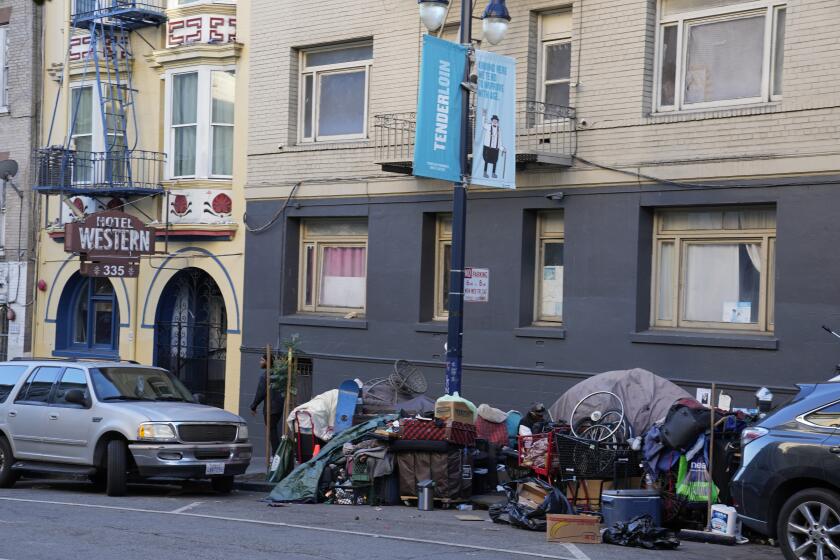‘Now, We Have a Voice’ : Media: The city’s newest paper may be the first of its kind--one written by and for public housing residents. Organizers say it will give people a chance to share concerns and success stories.
Los Angeles’ newest newspaper is staffed by some of its poorest residents--a former battered woman with seven children and a paraplegic who lives on $964 a month, among others.
They are putting out what may be the first publication of its kind in the nation, one written solely by and for residents of public housing. The as-yet unnamed quarterly will go to the 32,447 people who live in 21 city housing projects from Pacoima to Watts.
The paper’s purpose is to provide residents with information about Los Angeles Housing Authority programs and to give them a forum to express common concerns that stretch across three area codes and dozens of gang boundaries. The Housing Authority is also hopeful that the paper--which will have sections written in Spanish, English, Vietnamese and Cambodian--will help forge a sense of community and pride among ethnic groups.
Public housing residents often complain that mainstream reporters write only about crime and violence in their neighborhoods.
“Now, we have a voice,” said Helen Sierra, president of the Housing Authority’s Resident Advisory Committee and a resident of the Dana Strand Village apartments in Wilmington.
The newspaper cleared its first major hurdle last year when the Housing Authority got about $400,000 from the U.S. Department of Housing and Urban Development to publish through 1995, after which residents hope the paper will become self-supporting through ad sales.
But the paper’s editor, Hugo Garcia--a bilingual journalist with 15 years experience in community newspapers in East Los Angeles--still faces some unusual obstacles in getting out the Aug. 1 premiere edition.
There is the resident-cum-news editor who can’t make it to an editorial meeting downtown from Mar Vista Gardens in Culver City because he doesn’t have money for gas or parking. Housing Authority officials are checking to see if federal regulations allow them to use the grant money for transportation. They are also trying to figure out how much to pay staff members.
Then there are the little matters of training a resident to take over as editor and of teaching basic journalism skills to would-be reporters and photographers, some of whom never graduated from high school.
But the biggest problem may be overcoming residents’ suspicions regarding anything produced by the Housing Authority. The agency is haunted not only by the usual tenant antipathy toward operators of government-subsidized housing, but also by its own scandal-ridden history.
“They don’t trust us,” said Marshall Kandell, the agency’s communications director. Only a handful of people volunteered to work for the paper despite thousands of recruitment fliers that accompanied March rent bills, he said.
But agency officials are confident that the paper will be a success once the first issue lands on tenants’ doorsteps. They point out that the Housing Authority has come a long way since the late 1980s, when two controversial and ineffective executive directors resigned and HUD designated the agency as “operationally troubled.”
The agency was removed from that list last year, partly because it has succeeded in forging partnerships in which tenants help make decisions about how the World War II-era apartment complexes are operated, HUD officials said. The newspaper is essential to continuing that progress, they said.
“It’s not intended to be a mouthpiece for the Housing Authority,” said Joseph Shuldiner, the agency’s former executive director who was recently appointed assistant secretary of HUD for public and Indian housing. “One would hope it would not become an anti-house organ either, but residents are entitled to raise issues without any political censorship.”
The paper will differ from a HUD-funded, bimonthly newspaper distributed to 230,000 project residents in New York City. That paper is written and edited almost exclusively by an employee of the Housing Authority there.
With Los Angeles public housing residents showing only marginal interest thus far, Garcia is scrambling to find residents willing to fill the paper--which will either be a 32-page tabloid or a 16-page broadsheet--with local news.
“We’ll accept just about anything from anybody, even gangbangers,” said Garcia, who will earn about $26,000 annually until he hands off the paper to a resident-editor in 1996.
So far, he has scheduled stories on a recent softball game between gang members and Housing Authority employees, and on a joint venture between the residents’ council and private companies to modernize some apartment units. There is also a feature planned on a resident who found a missing dog belonging to a terminally ill child and another on a social club for seniors.
Maria Mendia, 34, of San Fernando Gardens in Pacoima is helping to put together a story on HUD Secretary Henry Cisneros’ visit to Imperial Courts in May. The mother of seven ultimately wants to write an advice column for battered women. She recently attended one of a series of basic journalism workshops given by the Housing Authority.
“I (have) been abused for many years before, and I know how they feel when the men hit,” Mendia said. “You go to court and try to cover up. You don’t say nothing because you’re scared. Then they hit you again. I learned my lesson, and I don’t want other ladies to pass through what I passed through.”
Michael Just, 35, a resident of Owensmouth Gardens in Woodland Hills, was paralyzed from the waist down in 1982 when a drunk driver hit his car. He has volunteered to write an editorial for the paper criticizing people with minor medical conditions who use handicapped parking spaces.
“I think the paper will help people realize that project residents aren’t just a bunch of schmoes sitting around watching soap operas and fighting,” said Just, who recently graduated from Cal State Northridge and hopes to earn a master’s degree in counseling.
Some residents see the paper as a steppingstone to getting a job.
“I love graphics, that’s what I want to do,” said Christopher Offoh, the Mar Vista Gardens resident who supports his family on $800 a month and can’t afford the gas to travel to editorial meetings. “I just need a ride down there.”
Future issues will include stories on such Housing Authority programs as a $100-million effort to remove lead-based paints from the projects, which can cause brain damage if ingested.
The paper will largely avoid focusing on crime, except for major incidents, Garcia said.
“The only time the projects are in the news is when something negative happens, and people there are sick and tired of it,” Garcia said.
Another reason is that the Housing Authority is concerned about the risks of reprisals if residents file crime stories.
“It’s one thing for The Times to send reporters in, but we’ve got people that have to live there, and we don’t want anyone killed,” the Housing Authority’s Kandell said. “Still, we’re going to have ugly stories here, and we’re going to report them.”
Times correspondent Carmen Valencia contributed to this story.
Sign up for Essential California
The most important California stories and recommendations in your inbox every morning.
You may occasionally receive promotional content from the Los Angeles Times.



